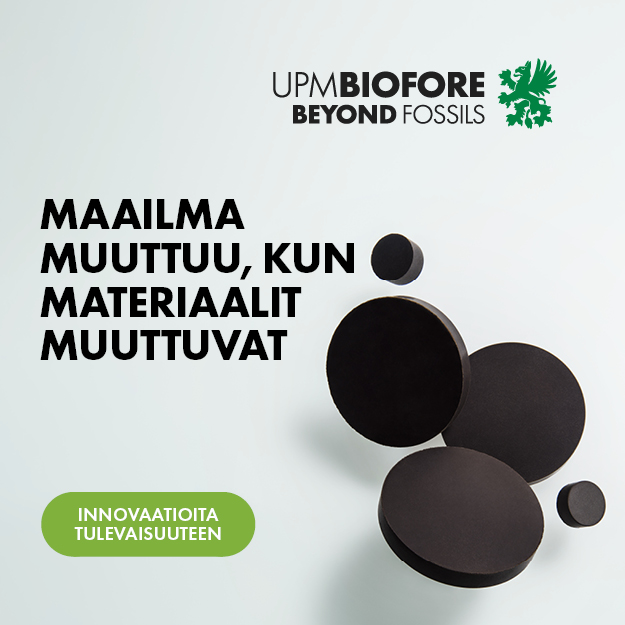The Sunila pulp mill is the only one in the world which produces dry lignin to the market. Thanks to a EUR 32 million investment, its production capacity is 50,000 tonnes. The mill, established in 1938, started the production of lignin in 2015.
The mill’s Development Director Jarmo Rinne describes the potential applications of lignin as virtually limitless. In paints and glues, it can replace phenols. It can also be used as a raw material for carbon fibre in the automobile and aircraft industries as well as in solar panels and sports equipment. In addition to this, it is an excellent source of energy.
“We’re doing our part to realise Stora Enso’s strategy, according to which you can make the same things out of wood that you currently make from oil. Lignin can replace fossil-based chemicals in a wide variety of products,” says Rinne.
An unpromising future
The outlook for Sunila is good now, but ten years ago, this was not the case – the mill’s production was halted in 2009.
“The outlook for a pulp producer at the time was extremely poor, and pulp mills were being closed everywhere. That was the sprit of the times, and the decisions were made according to the knowledge and views prevalent at the time,” says Rinne, not giving in to hindsight.
The gloomy prospects weighed on spirits at Sunila, and many left the mill to seek jobs elsewhere. The mill received a further blow when Stora Enso’s stock exchange release announced that the company was planning to close the mill down the permanently. Finally, late in the year, Rinne was invited to a meeting.
“I remember the event and its atmosphere very well. I thought that this would be the meeting in which they’d tell us of the decision to close down the mill. The situation turned out to be completely different, when they informed us that the mill would be restarted. It felt incredible, and people’s emotions went through the roof,” says Rinne.
This announcement made the staff eager to demonstrate their know-how. Production was started up in record time, even though the chemicals and raw materials had already been shipped out. After this, the forecasts also became more optimistic, as the pulp market started recovering at a fast rate. This also rekindled faith in Sunila, and employees started to return to the mill.
Process optimisation
Nowadays, the mill has some 160 employees, and the mill area has a total of roughly 250 employees.
Rinne describes Sunila as a fairly small pulp mill in modern terms, given that its production capacity is 375,000 tonnes of bleached sulphite pulp made from softwood. In addition, the mill produces lignin, tall oil and turpentine.
Is it absolutely necessary for a mill this size to produce other products alongside pulp?
“I don’t know whether it’s absolutely necessary, but it’s one of the better alternatives. In our case, lignin, as well as tall oil and turpentine, play a very important role in terms of the mill’s financial standing,” says Rinne.
Several factors were at play when Sunila, out of all Stora Enso pulp mills, was selected to produce lignin.
“Our raw materials management and cooking process produce good lignin of a consistent quality, which is an excellent raw material for the chemical industry. Furthermore, our energy balance allowed for extracting lignin from black liquor without inconveniencing the mill’s operation.”
The pulp mill does have ample potential for the production of lignin, since wood is 20–30 per cent lignin.
In pulp production, lignin ends up in the black liquor, which has traditionally been burned for energy in the mill’s recovery boiler. The lignin is extracted from the black liquor with a method called LignoBoost. How much lignin should be separated from the black liquor depends on the mill’s energy balance, to which it must be proportioned.
Sunila faced some new challenges when setting up the lignin production process, given that it is the only production unit of its kind. Rinne says that special solutions had to be found for the functioning of the dryer, burning and the treatment of the dry lignin.
The fact that lignin dust is highly combustible only increased the production process’s degree of difficulty. This is why the lignin is treated in conditions devoid of oxygen.
“The safety system is very intricate,” says Rinne.
Pulp has risen in value
At Stora Enso, pulp mills nowadays operate under the Biomaterials division. Rinne considers the change significant.
“We became part of the division’s main business. It was a big change both in terms of attitudes and in practice. We now have a role to play in the company’s strategies, rather than being visible as a mere support function. Whereas pulp was previously considered just a necessary raw material for paper or board, it’s now a product in its own right.”
In addition to Finland, the Biomaterials division has operations in Brazil, Uruguay, Sweden and the United States.
“Each pulp mill is found its own role – a playing field which distinguishes it from the competitors,” says Rinne.
Sunila’s special know-how lies in lignin. Rinne admits that he feels pride in telling people that Sunila is the only producer of dry lignin of its kind in the world.
“We’ve really achieved something on our own here that hasn’t been done anywhere else. That said, I have to stress that it applies to the entire company in addition to the people working at Sunila. Together, we’ve developed unique solutions.”
What role will lignin play in Sunila’s future?
“It will be significant, that much is sure. We have a firm belief here that we have a few years’ head start, even if other units of this kind would enter the market. We’ve done a lot of development and solutions for the productions process that no one else knows except us.”
Text: Sami Laakso
Picture: Johannes Wiehn



